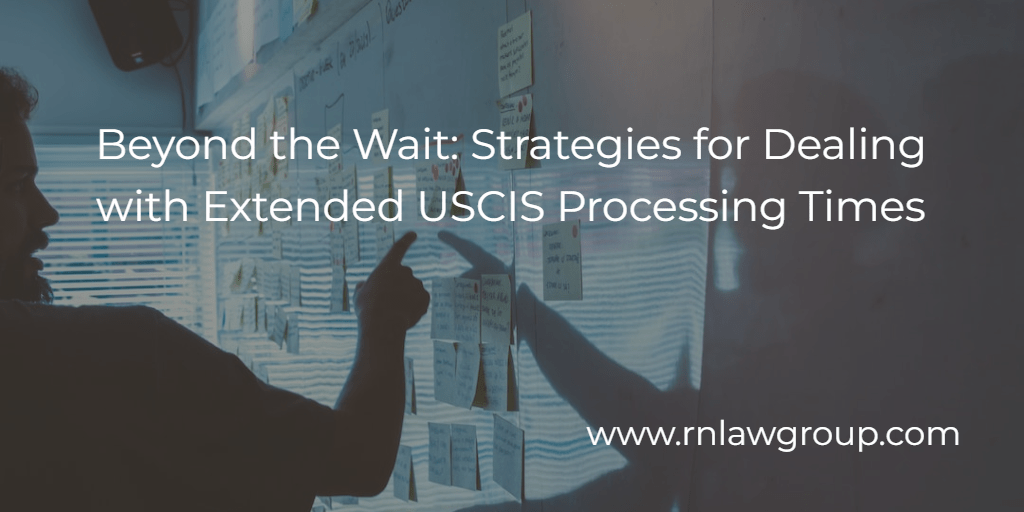
Beyond the Wait: Strategies for Dealing with Extended USCIS Processing Times
USCIS processing times play a crucial role in the immigration journey of individuals seeking various benefits in the United States. These times indicate the duration it takes for U.S. Citizenship and Immigration Services (USCIS) to adjudicate applications, petitions, and requests. Understanding the importance of these processing times, monitoring them regularly, and knowing how to navigate delays is essential for those navigating the complexities involved with obtaining immigrant and nonimmigrant benefits.
Monitoring USCIS Processing Times:
Every application, petition, or request submitted to USCIS will be assigned a Receipt Number upon adequate filing. To monitor USCIS processing times, applicants and petitioners can visit the official USCIS Processing Times website to look up the estimated processing times or use online tools provided by the agency to monitor the case status.
This user-friendly online resource offers real-time updates on the processing times for different forms types and requested form categories based on the service center it was filed to. The case status online tool allows you to monitor if your case is still pending, approved, denied, whether a request for additional evidence was issued, or whether your application or petition has been revoked. Regularly checking the processing times in conjunction with monitoring the case status allows applicants and petitioners to stay informed about any changes and anticipate potential delays. Further, it allows applicants and petitioners to decide whether an expedited processing option is a better fit option for their specific circumstance. This tool becomes most helpful when the applicant or petitioner observe that their pending application is processing beyond the estimated processing time provided in this notice.
Dealing with Delays:
When a case is pending beyond the stated processing time, applicants can take several steps. First, they can check the USCIS website for any official updates or announcements regarding delays. The USCIS processing times website provides a comprehensive overview of average processing times for various forms and offices. If there’s no information, contacting the USCIS National Customer Service Center or submitting an online inquiry can provide clarity on the status of the case. However, it is worth noting that the processing times provided on the website are an estimation based on the completed adjudication rate of only 80 percent of cases filed with USCIS. It is likely, that the case in question is outside the estimated processing time, but still within an acceptable processing time window for the remaining 20 percent of filed cases with USCIS.
Premium Processing to Expedite Processing Time:
USCIS offers a premium processing service for certain form types that expedites the adjudication process for an additional fee. The accepted USICS forms eligible for this expedited processing are: Form I-129, Form I-140, Form I-765, and/or certain Form I-539 visa categories. To file for premium processing, applicants and/or petitioners can follow these steps:
- Complete and sign Form I-907, Request for Premium Processing Service.
- Pay the appropriate filing fee, which can be found on the I-907, Request for Premium Processing Service USCIS website.
- Submit the completed Form I-907 and the filing fee to the direct mailing address specified in the form instructions.
This service ensures a quicker turnaround time, typically within 15 – 30 calendar days depending on the USCIS form type the expedited processing is being requested for. Applicants opting for premium processing receive faster decisions on their cases, which can be crucial in situations where time is of the essence, such as job offers or impending travel plans. If the premium processing time surpasses the guaranteed processing time, the petitioner, applicant, or legal representative on file can contact the premium processing service center directly as instructed on the receipt notice.
Not all forms are eligible for premium processing, and eligibility may change over time as well as the filing fees and applicable direct mailing addresses. It’s essential to check the premium processing service USCIS website for the most up-to-date information on form editions and the form types eligible for premium processing. While this option provides expedited service, applicants should carefully consider its applicability to their specific situation.
Filing an e-Service Request with USCIS:
If an applicant encounters delays beyond the posted processing times, they can file a service request with USCIS. This can be done by:
- Visiting the USCIS Case Inquiry page and selecting the “Case outside normal processing time” option
- Providing the required information about the case, including the receipt number and other relevant details.
- Submitting the request online.
As confirmation email will be sent to the contact email provided in the form confirming the assigned request ID number and expected response time from USCIS. It is worth noting that the processing times provided on the website are an estimation based on the completed adjudication rate of only 80 percent of cases filed with USCIS. It is likely, that the case in question is outside the estimated processing time, but still within an acceptable processing time window for the remaining 20 percent of filed cases with USCIS. In these cases, a message will be prompted explaining it is still within processing time and a request cannot be accepted at that time. You can generally file a new service request after at least 30 days have lapsed.
- The Role of the Ombudsman Office:
When all else fails, and an applicant or petitioner experiences prolonged delays without resolution, the USCIS Ombudsman Office becomes a valuable resource. The Ombudsman Office serves as an independent and impartial entity that assists individuals in resolving issues with USCIS. Applicants can submit a Case Assistance Request with the Ombudsman Office by following these steps:
- Visit the CIS Ombudsman Case Assistance Request page
- Complete the online form, providing detailed information about the case and the efforts made to resolve it through regular channels. The form allows for up to 10 supporting document attachments to be uploaded.
- Submit the Case Assistance Request online.
The Ombudsman Office reviews cases, facilitates communication between the applicant and USCIS, and works to resolve delays or issues. While not a direct appeals process, it serves as a mediator and can provide recommendations to USCIS to address specific cases. This resolution alternative can take an average of 30 – 60 days before a resolution correspondence is provided. Utilizing the mentioned USCIS online tools in conjunction with the Ombudsman Office can be a last resort for applicants facing significant delays or challenges in their immigration processes.
- Conclusion:
In conclusion, USCIS processing times are pivotal for individuals navigating the U.S. immigration system. Monitoring these times through the USCIS processing times website and online tools mentioned herein, understanding how to navigate delays, and exploring options like premium processing are essential steps to stay informed about your cases status. Additionally, the USCIS Ombudsman Office, coupled with real-time data provided by the USCIS, serves as a safeguard, offering assistance when traditional channels fail to provide timely resolution. Navigating the immigration journey requires not only a thorough understanding of the application process but also awareness of the resources available to address unexpected challenges.
Reddy & Neumann has been serving the business community for over 20 years and is Houston’s largest immigration law firm focused solely on U.S. Employment-based immigration. We work with both employers and their employees, helping them navigate the immigration process quickly and cost-effectively.
By : Jeanetly Garcia
Jeanetly Garcia advises employers and individuals through all phases of the non-immigrant visa process. As an attorney in the H-1B Department at Reddy Neumann Brown PC she is experienced in filing nonimmigrant petitions and applications for immigrant benefits, as well as, responding to USCIS issued requests for evidence concerning an array of legal issues.

